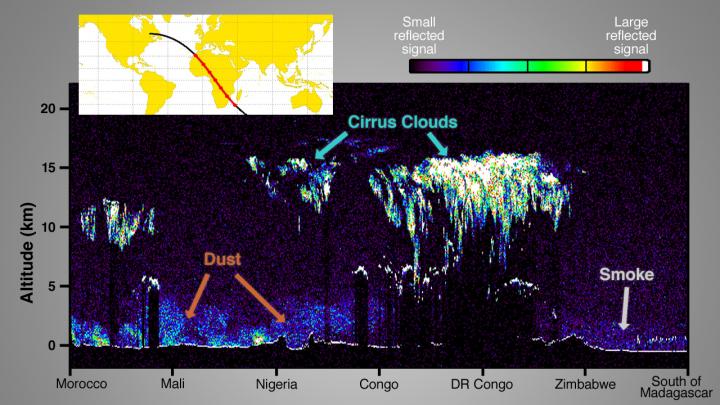Africa, From a CATS Point of View

This cross-section of the atmosphere over Africa shows clouds, dust and smoke from fires, as well as topography returned by the Cloud-Aerosol Transport System (CATS) instrument aboard the International Space Station. Credit: NASA
From Saharan dust storms to icy clouds to smoke on the opposite side of the continent, the first image from NASA's newest cloud- and aerosol-measuring instrument provides a profile of the atmosphere above Africa.
The Cloud-Aerosol Transport System instrument (CATS), was launched Jan. 10 aboard a SpaceX Dragon spacecraft, and was installed on the International Space Station on Jan. 22. From its berth on the station, CATS sends laser pulses toward Earth, detecting the photons that bounce off of particles in the atmosphere to measure clouds, volcanic ash, pollutants, dust and other aerosols.
“Everything's turned on and we're getting data, both daytime and nighttime,” said Matt McGill, principal investigator of CATS from NASA's Goddard Space Flight Center in Greenbelt, Maryland. “We can see the ground, stratus clouds, cirrus clouds and over Africa we can see desert dust. The photon-counting detection approach used in CATS appears to be more sensitive than previous lidar [light detection and ranging] sensors.”
The CATS image shows a profile of particles in the atmosphere over a swath of Africa, from 30 degrees North to 30 degrees South, as the space station flew over it in the early morning of Feb. 11.
Over northern Africa, particles – likely dust kicked up by Saharan windstorms – reach heights of 2.5 to 3 miles (4 to 5 kilometers), said John Yorks, science lead for CATS at Goddard. As the space station approached the equator, the instrument picked up higher atmospheric particles – thin, wispy ice clouds as high as 10 miles above the surface (16 km). South of the cloudy tropics, aerosols appeared closer to the ground, likely smoke from biomass burning. The results from CATS can also be combined with images of Earth from instruments like the Moderate Resolution Imaging Spectroradiometer, flown on the Terra and Aqua satellites.
The CATS team is calibrating data from the two wavelengths on the primary laser operating now – 532 nanometers and 1064 nanometers. The backup laser on CATS has three wavelengths. The different wavelengths reflect differently when they hit aerosols, so comparing the returns from multiple wavelengths allows the scientists to distinguish dust from ice, smoke or other airborne particles.
“The differences between wavelengths are subtle, but the ratio of the intensity of the reflection at different wavelengths indicate aerosol type,” Yorks said. The CATS team will also look at other characteristics of the laser pulse returns to help with particle identification.
Before receiving data plots like the one over Africa, the team aligned the telescope pointing. They used motors to adjust optics inside the instrument during nighttime segments until they got the strongest signal, indicating that the telescope's field of view aligned with the reflected laser photons.
“It's a difficult process, and it took us several days to get the telescope aligned,” Yorks said. “But once we did, we were able to see these really small features, such as the thin cirrus clouds and the thin aerosol layers.”
Data from CATS will help scientists model the structure of dust plumes and other atmospheric features, which can travel far distances and impact air quality. Climate scientists will also use the CATS data, along with data from other Earth-observing instruments, to look at trends and interactions in clouds and aerosols over time.
CATS is not only a science instrument, but a demonstration of how researchers can use the space station as a base for Earth-observing studies.
“The ISS is an interesting, low-cost platform for demonstrating new Earth Science measurements and technologies,” McGill said. “For example, the ability to downlink data, continuously, in near-real time is a great advantage for testing flow of data into predictive models. However, practical limitations come with the ISS platform. For example, interruptions to operations occur due to visiting vehicle arrivals and departures. If your science demands 100 percent operational duty cycle, then ISS may not be the platform of choice.”
The CATS team is moving forward with calibration and improving computer programs to identify types of aerosols, and by April hopes to be able to provide a data product to aerosol monitoring groups three hours after the data are collected, and provide products to the public within 12 hours.
CATS was designed and built by a small team at Goddard, with funds from the International Space Station Program's NASA Research Office, which also provided a spot on the station. Funding for the processing of data comes from NASA's Earth Science Division. The instrument is designed to operate for at least six months, with a goal of three years.
###
For more information on CATS, visit: http://cats.
For more information on the International Space Station, visit: http://www.
Media Contact
All latest news from the category: Earth Sciences
Earth Sciences (also referred to as Geosciences), which deals with basic issues surrounding our planet, plays a vital role in the area of energy and raw materials supply.
Earth Sciences comprises subjects such as geology, geography, geological informatics, paleontology, mineralogy, petrography, crystallography, geophysics, geodesy, glaciology, cartography, photogrammetry, meteorology and seismology, early-warning systems, earthquake research and polar research.
Newest articles

Durable, Efficient, Sustainable: The Rise of Cerium Oxide Thermal Switches
Groundbreaking cerium oxide-based thermal switches achieve remarkable performance, transforming heat flow control with sustainable and efficient technology. Cerium Oxide-Based Thermal Switches Revolutionize Heat Flow Control Thermal switches, which electrically control…

How Industrial Robots are Reducing Emissions in Global Manufacturing
A new study explores the intersection of industrial automation and environmental sustainability, focusing on the role of industrial robots in reducing the carbon intensity of manufacturing exports. The research demonstrates…

Patients Can Heal Through Precise, Personalized Bioceramic Grafts
A recent review is transforming the landscape of craniomaxillofacial bone regeneration with the introduction of personalized bioceramic grafts. This pioneering research explores the fabrication and clinical potential of synthetic grafts…



